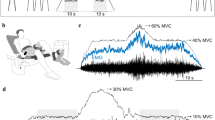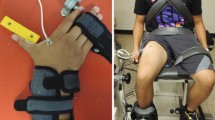Abstract
The electromyogram (EMG) and intramuscular pressure (IMP) increase linearly with force during voluntary static contractions, while the surface mechanomyogram (MMG) increases linearly only up to approximately 70% of the maximal voluntary contraction (MVC) and then levels off. The aim of this study was to investigate the possible influence of IMP on the non-linear MMG increase with force and hence on the signal generation process. Seven subjects performed static contractions of the elbow flexors during: (1) ramp contractions from 0 to 60% of the MVC, and (2) steps at 10, 20 and 40% of the MVC. An external pressure of 0 and 50 mmHg for the ramps or 0, 20, 40, 60, 80 and 100 mmHg for the steps was applied by means of a sphygmomanometer cuff in separate trials. The EMG and the MMG were detected in the biceps brachii by means of a pair of surface electrodes and an accelerometer. The IMP was measured using a Millar tipped pressure transducer, and the data was presented as the mean and standard deviation in each case. The IMP was strongly and linearly related to the external pressure and contraction force both during ramps and steps. The EMGrms and MMGrms were never reduced as a consequence of the IMP increments. In contrast, a steeper MMGrms versus %MVC relationship during ramps at 50 mmHg cuff pressure, and an influence of the cuff pressure at 40% of MVC on MMGrms were evident. We conclude that IMP per se does not attenuate the MMG generation process during voluntary contraction, suggesting that the previously described MMGrms decrease at near maximal static efforts must be attributed to other determinants, such as a fusion-like situation due to the high motor unit firing rate.





Similar content being viewed by others
References
Akataki K, Mita K, Watakabe M, Itoh K (2001) Mechanomyogram and force relationship during voluntary isometric ramp contractions of the biceps brachii muscle. Eur J Appl Physiol 84:19–25
Akataki K, Mita K, Watakabe M, Itoh K (2003) Mechanomyographic responses during voluntary ramp contractions of the human first dorsal interosseus muscle. Eur J Appl Physiol 89:520–525
Barry DT (1987) Acoustic signals from frog skeletal muscle. Biophys J 51:769–773
Barry DT (1991) Muscle sounds from evoked twitches in the hand. Arch Phys Med Rehabil 72:573–575
Barry DT, Cole NM (1990) Muscle sounds are emitted at the resonant frequencies of skeletal muscle. IEEE Trans Biomed Eng 37:525–531
Barry DT, Geiringer SR, Ball RD (1985) Acoustic myography: a non-invasive monitor of motor unit fatigue. Muscle Nerve 8:189–194
Basmajian JV, De Luca CJ (1985) Muscles alive: their functions revealed by electromyography, 5th edn. Williams and Wilkins, Baltimore
Brown H, Prescott R (2001) Applied mixed models in medicine. John Wiley & Sons, Chichester
Clamann HP (1970) Activity of single motor units during isometric tension. Neurology 20:254–260
Frangioni JV, Kwan-Gett TS, Dobrunz LE, McMahon TA (1987) The mechanism of low-frequency sound production in muscle. Biophys J 51:775–783
Gordon G, Holbourn HS (1948) The sounds from single motor units in a contracting muscle. J Physiol 107:456–464
Korner L, Parker P, Almstrom C, Andersson GB, Herberts P, Kadefors R, Palmerud G, Zetterberg C (1984) Relation of intramuscular pressure to the force output and myoelectric signal of skeletal muscle. J Orthop Res 2:289–296
Orizio C (2000) Muscle fatigue monitored by the force, surface mechanomyogram and EMG. In: Nigg BM, MacIntosh BR, Mester J (eds) Mechanics and biology of movement. Human Kinetics, Champaign, pp 409–433
Orizio C, Perini R, Diemont B, Maranzana-Figini M, Veicsteinas A (1990) Spectral analysis of muscular sound during isometric contraction of biceps brachii. J Appl Physiol 68:508–512
Orizio C, Gobbo M, Diemont B, Esposito F, Veicsteinas A (2003) The surface mechanomyogram as a tool to describe the influence of fatigue on biceps brachii motor unit activation strategy. Historical basis and novel evidence. Eur J Appl Physiol 90:326–336
Ouamer M, Boiteux M, Petitjean M, Travens L, Salès A (1999) Acoustic myography during voluntary isometric contraction reveals non-propagative lateral vibration. J Biomech 32:1279–1285
Sadamoto T, Bonde-Petersen F, Suzuki Y (1983) Skeletal muscle tension, flow, pressure, and EMG during sustained isometric contractions in humans. Eur J Appl Physiol 51:395–408
Sejersted OM, Hargens AR, Kardel KR, Blom P, Jensen Ø, Hermansen L (1984) Intramuscular fluid pressure during isometric contraction of human skeletal muscle. J Appl Physiol 56:287–295
Sjøgaard G, Kiens B, Jørgensen K, Saltin B (1986) Intramuscular pressure, EMG and blood flow during low-level prolonged static contraction in man. Acta Physiol Scand 128:475–484
Søgaard K, Blangsted AK, Jørgensen LV, Madeleine P, Sjøgaard G (2003) Evidence of long term muscle fatigue following prolonged intermittent contractions based on mechano- and electromyograms. J Electromyogr Kinesiol 13:441–450
Sjøgaard G, Jensen B R, Hargens A R, Søgaard K (2004) Intramuscular pressure and EMG relate during static contractions but dissociate with movement and fatigue. J Appl Physiol 96:1522–1599
Stokes MJ, Blythe M (2001) Muscle sounds in physiology, sports science and clinical investigation. Applications and history of mechanomyography. Medintel Monographs, Oxford
Acknowledgements
This work was supported by the European Shared Cost project NEW-Neuromuscular assessment in Elderly Workers (QLRT-2000-00139) and partly by a European Space Agency grant (AO-LS-99MAP). The authors are grateful to Henrik Baare Olsen for his competent contribution to the data analysis and Dr. Giovanni Parrinello for his contribution to the identification of the most correct statistical model for data analysis.
Author information
Authors and Affiliations
Corresponding author
Rights and permissions
About this article
Cite this article
Søgaard, K., Orizio, C. & Sjøgaard, G. Surface mechanomyogram amplitude is not attenuated by intramuscular pressure. Eur J Appl Physiol 96, 178–184 (2006). https://doi.org/10.1007/s00421-004-1211-5
Accepted:
Published:
Issue Date:
DOI: https://doi.org/10.1007/s00421-004-1211-5




